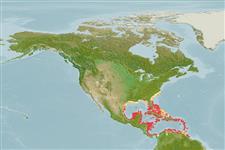Environment: milieu / Klimaatzone / Diepte / distribution range
Ecologie
marien rifbewoner; diepte 2 - 20 m (Ref. 9710). Subtropical; 21°C - 28°C (Ref. 4858); 37°N - 8°N, 100°W - 58°W (Ref. 55198)
Western Atlantic: Massachusetts, USA and Bermuda to West Indies and northern South America. Also Bahamas, Gulf of Mexico, and Antilles (Ref. 26938).
Lengte bij maturiteit / Grootte / Gewicht / Leeftijd
Maturiteit: Lm 9.2 range ? - ? cm
Max length : 15.0 cm TL mannelijk / geslacht onbekend; (Ref. 47838)
Dorsale stekels (totaal) : 13; Dorsale zachte stralen (totaal) : 17 - 20; Anale stekels: 3; Anale zachte stralen: 16 - 17. Large black spot surrounded by a white ring on body below rear of dorsal fin. Narrow, dark, diagonal lines that meet at mid-side, forming series of forward-pointing chevrons (Ref. 26938). Upper profile of head steep and slightly concave due to protruding snout; light gray, shading to pale yellowish on sides; a black bar on head; pelvic fins yellow (Ref. 13442).
Body shape (shape guide): short and / or deep; Cross section: compressed.
Inhabit shallow reefs and generally occurs singly or in pairs. Feed mainly on zoantharians, polychaete worms, gorgonians and tunicates. Easily approached (Ref. 9710). Oviparous (Ref. 205). Form pairs during breeding (Ref. 205).
Levenscyclus en paargedrag
Maturiteit | Voortplanting | Paaien | Eieren | Fecunditeit | Larven
Form pairs during breeding (Ref. 205). Monogamous mating is observed as obligate, genetic and social (Ref. 52884).
Allen, G.R., 1985. Butterfly and angelfishes of the world. Vol. 2. 3rd edit. in English. Mergus Publishers, Melle, Germany. (Ref. 4858)
Status op de Rode Lijst van het IUCN (Ref. 130435: Version 2024-2)
Gevaar voor de mens
Reports of ciguatera poisoning (Ref. 30303)
Gebruik door de mens
Visserij: commercieel; Aquarium: Commercieel
Tools
Speciale rapporten
Download XML
Internetbronnen
Estimates based on models
Preferred temperature (Ref.
123201): 25.5 - 28.2, mean 27.4 °C (based on 558 cells).
Fylogenetische diversiteitsindex (Ref.
82804): PD
50 = 0.5000 [Uniqueness, from 0.5 = low to 2.0 = high].
Bayesian length-weight: a=0.02512 (0.01634 - 0.03862), b=3.09 (2.96 - 3.22), in cm total length, based on LWR estimates for this species & Genus-body shape (Ref.
93245).
Trofisch niveau (Ref.
69278): 3.4 ±0.0 se; based on diet studies.
Weerstandsvermogen (Ref.
120179): Hoog, minimale populatieverdubbelingstijd minder dan 15 maanden (Preliminary K or Fecundity.).
Fishing Vulnerability (Ref.
59153): Low vulnerability (10 of 100).
🛈
Nutrients (Ref.
124155): Calcium = 71.8 [32.5, 146.8] mg/100g; Iron = 0.862 [0.451, 1.608] mg/100g; Protein = 19.4 [18.2, 20.6] %; Omega3 = 0.177 [0.093, 0.335] g/100g; Selenium = 13.8 [6.0, 29.9] μg/100g; VitaminA = 31.9 [7.6, 133.5] μg/100g; Zinc = 1.01 [0.60, 1.61] mg/100g (wet weight);
